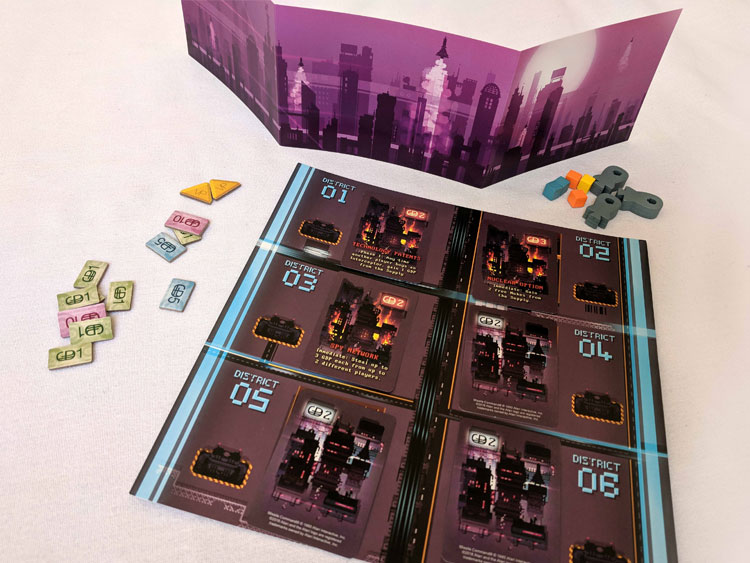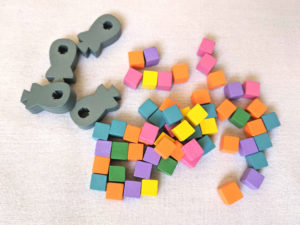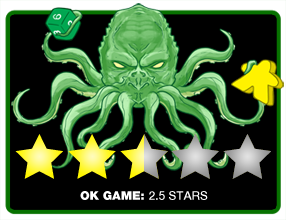“No one is sure how it came to be, but the war has begun – a war fought not with tanks or guns, but with missiles.”
 In Missile Command, the latest entry into IDW’s series based on classic Atari games, each player controls six cities. From there they build and deploy missiles, nukes, or countermeasures, hoping to protect their own city while destroying their opponents. Players can negotiate temporary alliances and plot secret attacks before destruction rains down from above.
In Missile Command, the latest entry into IDW’s series based on classic Atari games, each player controls six cities. From there they build and deploy missiles, nukes, or countermeasures, hoping to protect their own city while destroying their opponents. Players can negotiate temporary alliances and plot secret attacks before destruction rains down from above.
Missile Command is a deployment and negotiation game for 3 to 6 players that lasts about 30-40 mins. It plays best with 5-6 players.
Gameplay Overview:
Each player starts with a city board seeded with six face down city tiles, a radar screen for hiding supplies and actions, and fifteen GDP. Play consists of four phases: negotiate, plan, fire missiles, and collect GDP.

In the negotiation phase, players can make alliances, trades, sales, and plan strategy with other players. But negotiate wisely – any agreements made during this phase that do not occur immediately are non-binding! Additionally, players use GDP to buy the weapons and defenses.
Phase two, the planning phase, consists of planning your attack and defenses. This is done by placing purchased or traded resources (missiles, interceptors, and nukes) on the planning board behind their radar screen to indicate their actions in phase three.
Fire missiles in phase three. All players move their screens to reveal their actions during this turn. Fire is exchanged – cities are damaged or destroyed by missiles, and nukes yield damage to multiple cities. Defensively, interceptors can prevent damage to cities, and collisions from multiple enemy attacks may knock missile from the sky before they have time to do any real damage.
Finally, the wrap up and GDP collection of Phase 4. Players receive money based on their undamaged cities. Additionally, destroyed cities will yield powerful resource bonuses and more GDP which will be collected during this phase.
Play ends as soon as one player loses all of their cities. Player then up points based cities and resources they have left. Highest score wins.

Game Experience:
1983 was a simpler time. A BMX bike and converse tennis shoes granted you access to the cool side of the playground. On TV, an elite combat unit falsely accused of a crime they didn’t commit solved problems that no one else could. And a little black and brown box hooked up to your parent’s TV would bring the arcade into your living room.
I was super excited to get Missile COmmand. The cover art is very evocative of the original game art and for a brief moment, I was back in a wood paneled room full of laughing, scabby kneed kids, chewing Bubblicious and waiting for my turn to play. Some of the components double down on that art as well.

Overall, Missile Command seems like it should mostly consist a lot of negotiation. The entire first phase consists of bargaining, wheeling, and dealing. Or at least, its meant to. In both times I played, the group quickly realized that the inability to ‘seal the deal’ (alliances and agreements for future concessions are non-binding) meant nothing was safe, and it was far easier to become self reliant than get stabbed in the back. It quickly turned into more of a strategy game, trying to determine which cities to lose and how quickly in order to get better resource and money bonuses.
I love that the “missiles” are cubes – once again, that nostalgia coming in strong with something evocative of a pixel. Unfortunately, the yellow text on green in the player screens is difficult to read, as is the red text on the damaged side of the city cards. The player boards and planning boards are thin and bend easily. Shields can be added if you want a longer play experience, but as they add no additional game play function they seemed somewhat superfluous.
The city bonuses are interesting, these give you some type of additional power or resource once a city is destroyed. Due to the nature of setup, you don’t know what the bonus you have it until the card is flipped. These add some benefits to keep you viable in the game, but they’re somewhat unbalanced, ranging from “oh, thats interesting” Industrial Efficiency (buy 2 missile during the planning phase) to “well, I’m a superpower now” Smuggled Explosive (discard 2 missiles to destroy an undamaged city of your choice.)
Final Thoughts:
Missile Command delivers visually on the 80s nostalgia (no duh), but the gameplay is somewhat less than righteous. Some fun individual mechanics, but lack of balance is an issue. Unless your group is big into free wheeling negotiation, put your quarters into IDW’s Centipede instead.
Final Score: 2.5 Stars – High on the nostalgia, lower on playability.
 Hits:
Hits:
• Hits all the right notes on the nostalgia scale.
• City bonuses help keep players from failing early.
Misses:
• Non-binding negotiation is gnarly.
• Visual accessibility issues with some of the game components.
• Lack of balance in city bonus can make this game one-sided very quickly.























